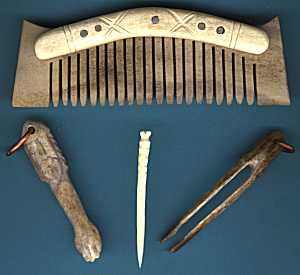It appears to be that the best sources on north-western Europe and Scandinavia were observations recorded by the Romans as they tried to push the boundaries of their frontiers. We haven’t covered body hair in the Roman Empire yet, but suffice to say, the face of the average Roman in his prime was clean-shaven. So the full, striking beards of the Celts (various groups from the British Isles) and Vikings (from Scandinavia) made an impact.
One source shows that Julius Caesar wrote about the “Britons” (apparently all Celts, though this may not be accurate) that they kept long hair and had "every part of their body shaved except their head and upper lip.” According to some sources, beards and/or mustaches could be braided, and others claim the Celts in particular used lime to bleach their beards and head hair. It is speculated that this was for intimidation on the battlefield, but whether it was or not, it sounds like it was a fearsome sight to the Romans.
There is also suggestion that Vikings and Celts attached abundant body hair to higher status. A Roman historian, Diodorus Siculus, observed that some shaved their faces completely, but higher ranks left "a mustache that covers the whole mouth.” The masculine instinct that head and body hair connotes virility, perhaps?
I wanted to dig a little further into north-western European aesthetics and found a bit more information spanning 8th to the 13th century, primarily for Viking culture. For example, according to some who have looked at Viking literature, physical attractiveness was directly related to a fictional or historical person’s rank and/or moral character. They would often be named for their physical characteristics, as well, particularly if they were unattractive or antagonistic in some way. Even being dirty was a negative characterization.
 This might be surprising, based on what we've seen in movies, but Vikings were apparently very neat and tidy. A law book from Iceland contains severe punishment for someone who pushed a man into dirty water, urine, food, or otherwise made him dirty on purpose. Tools for grooming (pictured) have been found in both male and female graves. I read that said other groups knew to attack Nordic invaders during their hot-spring bath time. A Viking treaty was found demanding that they be provided not only food and supplies, but baths as well. According to a couple of sources, the women of an invaded country supposedly found Vikings attractive because they were better groomed than their own men. It was a woman’s job to wash and cut her man’s hair, particularly as part of a ritual before he left on a campaign.
This might be surprising, based on what we've seen in movies, but Vikings were apparently very neat and tidy. A law book from Iceland contains severe punishment for someone who pushed a man into dirty water, urine, food, or otherwise made him dirty on purpose. Tools for grooming (pictured) have been found in both male and female graves. I read that said other groups knew to attack Nordic invaders during their hot-spring bath time. A Viking treaty was found demanding that they be provided not only food and supplies, but baths as well. According to a couple of sources, the women of an invaded country supposedly found Vikings attractive because they were better groomed than their own men. It was a woman’s job to wash and cut her man’s hair, particularly as part of a ritual before he left on a campaign. Men who couldn’t grow a beard were mocked. It was apparently a huge insult to accuse a man of having feminine characteristics. There was one ancient narrative examined online about a man who was wealthy with a family, but he could not grow a beard. Someone suggested he spread fertilizer on his chin, and his children came to be known as “Little Dung-beards.” Another character in the story made a poem to that effect, and one of the beardless man's children murdered him for it. The Vikings were certainly into "manliness" as well as cleanliness.
By contrast, a law book was found forbidding women from having masculine traits such as wearing their hair short. Some tribes may have cut the hair of their slave women. There is a Norse myth that Loki once cut off Sif’s hair as a prank, and Thor told Loki to either replace her hair or be killed. The most attractive parts of a woman were her eyes, hair, and arms; much else was covered. And considering how infants born with a deformity were thought of as not human and therefore abandoned, it makes you wonder how a hirsute woman might have survived in that culture? At least they did have razors so they could have shaved...
No comments:
Post a Comment